#controlsystem
Text

#plcprogramming#plc#automation#programming#industrialautomation#scada#automationengineering#s#hmi#siemens#electricalengineering#plcsiemens#controlsystem#siemensplc#plctraining#instrumentation#electrical#automationsolutions#tiaportal#robotics#industrialcontrol#factoryautomation#training#competitiveprogramming#engineering#programmingart#industrial#programmingclass#programmer#automatizacion
4 notes
·
View notes
Text
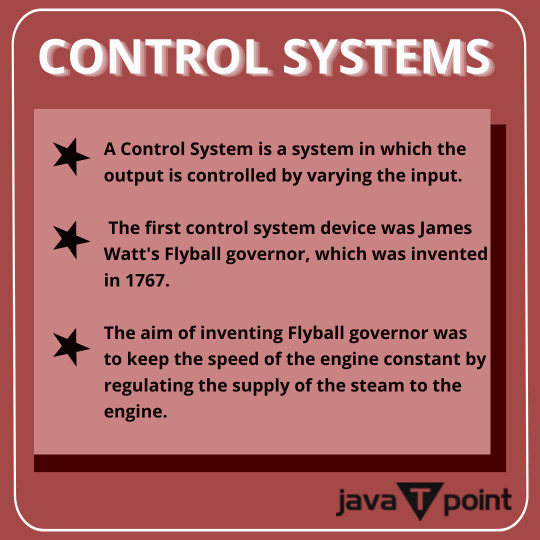
1 note
·
View note
Text
Control engineering overview
December 18, 2023
by dorleco
with no comment
Control Systems
Edit
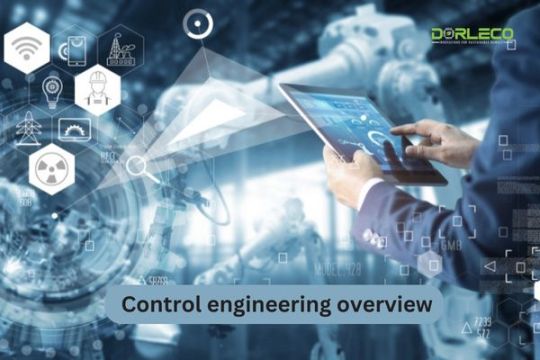
Introduction
A subfield of engineering known as control engineering is concerned with the planning, development, and use of systems that govern or control other systems. The main objective is to manipulate the inputs of a system to ensure that it performs as desired. Numerous industries, including robotics, aircraft, automotive, and manufacturing, depend on this field.
Here’s an overview of key concepts in control engineering:
Control System:
Components of a control system cooperate to sustain a desired response or output. It consists of the system itself, a controller, actuators, and sensors.
Types of Control Systems:
An open-loop control system does not feedback its output to its input. The system does not adapt to changes; instead, it is dependent on a starting set of conditions.
Closed-Loop Control System (Feedback Control System): The system’s behavior is adjusted by comparing the output to the intended reference signal and using the difference (error) as a guide.
Components of a Control System:

Controller: Determines what has to be done to keep or reach the target output.
Actuator: Puts the control signals the controller generates into action to modify the system.
Control Techniques:
PID control is a popular control approach that modifies the control effort according to the error signal’s proportional, integral, and derivative terms.
Optimal Control: Determines the ideal control inputs by applying mathematical optimization techniques.
Adaptive control modifies the controller’s parameters in response to shifts in the dynamics of the system.
Performance and Stability:
Stability: After a disturbance, a stable system goes back to its intended state.
Performance: This is the degree to which the control system meets its objectives, taking into account variables like resilience, precision, and response time.
Applications:
Industrial automation: Managing production procedures to ensure effectiveness and quality.
Systems used in aircraft and automobiles: cruise control, flight control, etc.
Motion control and trajectory planning in robotics.
Drug distribution and patient monitoring systems are examples of biomedical systems.
Digital Control Systems:
Digital Control Systems: (DCP) is the analysis and processing of signals in a digital format in digital control systems.
PLCs and microcontrollers are popular platforms for digital control system implementation.
Simulating & Modeling:
Mathematical Models: Use mathematical formulas to depict the behavior of the system.
Simulation is the process of predicting and analyzing a system’s reaction to various inputs or disturbances using models.
Human-Machine Interface (HMI):
HMI, or human-machine interface, involves creating user interfaces for control systems so that people may communicate with and observe them.
Benefits of Controls Engineering
Numerous benefits are provided by control engineering in a range of sectors and uses. Here are a few main benefits:
Increased Efficiency:
In sectors like manufacturing, where exact management of equipment and production procedures is essential, control systems optimize operations and processes, increasing efficiency.
Enhanced Output:
By controlling variables and making sure they adhere to specified parameters, control systems have the potential to improve system performance. In fields like robotics, aircraft, and automotive systems, this is essential.
Consistency and Quality:
By guaranteeing that processes are strictly regulated, control engineering contributes to the consistent production of high-quality products. For industries with strict criteria for product quality, this is essential.
Reduced Human Error:
By reducing the need for manual intervention, automated control systems help lower the possibility of human error. This is particularly crucial for vital systems like nuclear power plants and medical apparatus.
Enhanced Safety: To protect operations and users, control systems are used in a variety of safety-critical applications, such as emergency shutdown systems in chemical plants and anti-lock brake systems in cars.
Optimization of Resources:
Controls engineering makes it possible to optimize the use of resources, including raw materials, energy, and time. Cost reductions and a more resource-sustainable usage of resources may result from this.
Flexibility and Adaptability:
Adaptive control techniques give systems the flexibility to deal with dynamic situations by enabling them to adapt to changes in operating conditions or surroundings.
Remote Control and Monitoring:

Accuracy & Precision:
Control systems can precisely control parameters, producing results that are repeatable and accurate. This is important for applications where precision is critical, such as laboratory equipment.
Energy Effectiveness:
By streamlining system operations and cutting down on wasteful energy use, control engineering significantly contributes to increased energy efficiency. With the emphasis on sustainable practices these days, this is especially crucial.
Rapid Response to Disturbances:
To preserve stability and performance, control systems can react swiftly to disruptions or changes in the system. This is crucial for systems that need to make quick changes, such as flight control systems in airplanes.
Advanced Diagnostics and Fault Detection:
Proactive maintenance and reduced downtime are made possible by control engineering‘s real-time fault detection and diagnosis features.
Disadvantages of controls engineering
Although control engineering has many benefits, there are drawbacks and difficulties as well. The following are a few disadvantages of control engineering:
Complexity:
Control systems, particularly in large-scale industrial applications, can be extremely complicated. Complex control system design, implementation, and maintenance call for specific knowledge and experience.
High starting price:
Control system implementation might have substantial upfront costs for hardware, software, and installation. Smaller companies or industries with tighter budgets may find this to be a hindrance.
Maintenance Challenges:
To guarantee correct operation, control systems need to have regular maintenance performed. For many industries, the requirement for trained labor and the possibility of downtime during maintenance can be difficult.
Vulnerability to Cyber Security Threats:
As digital technologies are integrated more and more, control systems are exposed to cyber security risks. Control system manipulation or unauthorized access can have detrimental effects, particularly in critical infrastructure.
Limited Adaptability to Changes:
When the operating environment undergoes considerable changes, some control systems could find it difficult to adjust. This inability to adapt could be a drawback in fields that are dynamic and changing quickly.
Dependency on Technology:
The performance and dependability of the underlying technology affect the efficacy of control systems. The control process may be disrupted by hardware or software problems or failures.
Lack of Intuition:
Typically, mathematical models and algorithms underpin the operation of control systems. Even if they are incredibly accurate, in some circumstances they might not have the same intuition or capacity for decision-making as human operators.
Training and Skill Requirements:
Control system design, implementation, and maintenance need specific knowledge and abilities. There can be a scarcity of skilled workers, and continuing education is necessary to stay current with industry developments.
Over-reliance on Automation:
Over-reliance on automation may result in fewer people being involved in process control and monitoring. Operators may become less accustomed to the behavior of the system as a result, which may affect their capacity to react appropriately to unforeseen circumstances.
Unintended Consequences:
Unintended effects can occasionally result from alterations to the system or changes to the control parameters. Before implementing changes, engineers must carefully evaluate any possible negative impacts and conduct extensive testing.
Ethical and Legal Considerations:
Control systems pose legal and ethical issues, especially in fields like robotics and driverless cars. It is necessary to address concerns about decision-making in emergencies, liability, and responsibility.
Difficulty in System Modeling:

Conclusion:
In conclusion, control engineering stands as a crucial discipline with a wide range of applications that span industries from manufacturing to aerospace, robotics, and beyond. This field plays a pivotal role in shaping the efficiency, safety, and reliability of systems by utilizing advanced control strategies, feedback mechanisms, and automation technologies.
The advantages of control engineering are evident in the enhanced performance, increased efficiency, and improved quality it brings to various processes. Through precise regulation of variables, control engineering optimizes resource utilization, reduces human error, and contributes to the overall adaptability and flexibility of systems. Moreover, it plays a key role in achieving energy efficiency, a significant concern in the context of sustainable practices.
However, control engineering is not without its challenges. The complexity of control systems, high initial costs, and the need for specialized knowledge pose obstacles to implementation, especially for smaller businesses. Maintenance requirements, vulnerability to cyber security threats, and potential difficulties in adapting to changes in the operating environment add further dimensions to the challenges faced by the field.
As technology continues to advance, control engineering is likely to evolve with it. The ongoing integration of digital technologies, machine learning, and artificial intelligence will further shape the landscape of control systems. Addressing challenges such as cyber security threats, ensuring adaptability to dynamic environments, and balancing the role of automation with human oversight will be critical in the continued development and success of control engineering.
In essence, control engineering remains at the forefront of innovation, driving advancements that impact industries and society at large. The ongoing pursuit of precision, reliability, and efficiency in control systems underscores the importance of this field in shaping the future of technology and engineering.
#controlsystems#Controlengineering#Automotive#VCU#ECUs#ControlSystem#Dorleco#computervision#Autonomousvehicles#selfdrivingcars#CAN
1 note
·
View note
Text
Control Mechanisms and Gaining a Competitive Advantage

The Importance of Control
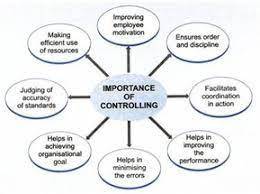
Types of Controls

Control Systems in Operations

ORGANIZATIONAL CONTROL AND STEPS IN THE CONTROL PROCESS

1 note
·
View note
Text
youtube
I wrote a simple program for Scene2. I implemented states using a word in memory to hold the state id and then compare and movp to change between the states. I also added timers to each state to generate a fault if the state does not complete without the expected time specified. I did not create any logic to handle the error so for now the PLC just flags and continues. Next I would add the routines for error handling and also the EMO logic. I will leave it for now and continue to the next simulation.
https://href.li/?https://github.com/grimmonkey52/Mitsubishi_PLC_projects/blob/main/FIO_SCENE2/SCENE2.pdf
0 notes
Text

Delve into the Core Components of Dust Collection Systems. Discover the Power Source, Particle Separators (Vessels), and System Control, and Elevate Your Workplace Cleanliness to New Heights!
For more details, visit- https://www.acmeairequipments.com/product/dust-collection-system/
0 notes
Text

VTT is a dependable static time delay relay ideal for tasks needing frequent operations and steady precision, often in industrial processes with minimal maintenance.
𝐂𝐨𝐧𝐭𝐚𝐜𝐭 𝐮𝐬 𝐨𝐧 +91 7021624024 𝐨𝐫 𝐠𝐞𝐭 𝐢𝐧 𝐭𝐨𝐮𝐜𝐡 𝐰𝐢𝐭𝐡 𝐮𝐬 𝐚𝐭 [email protected]
#alstomrelay#industrialtech#relaytech#precisionrelay#industrialcontrol#automation#electricalengineering#reliabletech#controlsystems#powermanagement
0 notes
Text
Applications of Control Systems Engineering in Everyday Life
Control Systems Engineering, often hailed as the backbone of modern technology, plays a vital role in shaping the functionality of various systems encountered in our daily lives. From regulating the temperature of our homes to optimizing the performance of our vehicles, control systems quietly work behind the scenes, ensuring efficiency and precision in numerous applications.
0 notes
Text

#plcprogramming#plc#automation#programming#industrialautomation#scada#automationengineering#s#hmi#siemens#electricalengineering#plcsiemens#controlsystem#siemensplc#plctraining#instrumentation#electrical#automationsolutions#tiaportal#robotics#industrialcontrol#factoryautomation#training#competitiveprogramming#engineering#programmingart#industrial#programmingclass#programmer#automatizacion
0 notes
Text

Elevate industrial automation with #PLC and #SCADA solutions! 🏭✨ Discover how our cutting-edge technologies enhance efficiency and control in manufacturing processes.
Reach Us: 8807148869
PLC SCADA
#PLC#SCADA#AutomationTech#ControlSystems#PLCProgramming#IndustrialAutomation#SCADASystems#SmartFactory#Industry40#ProcessControl#PLCSCADA#AutomationEngineer#IoTinIndustry#SmartManufacturing#FactoryAutomation#PLCTechnology#DigitalTransformation#SCADAControl#AutomationSolutions#TechInnovation
0 notes
Text
Autonomous Agricultural and Construction Vehicles
October 31, 2023
by dorleco
with no comment
Autonomous Vehicle Technology
Edit
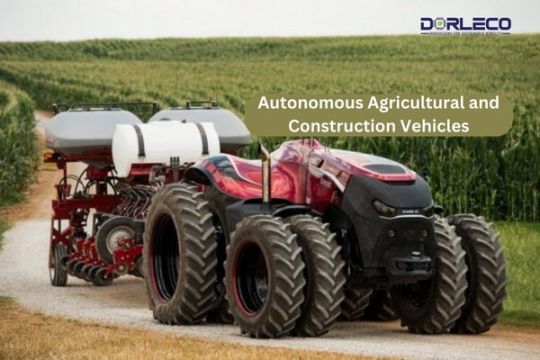
Introduction
A major technological leap in farming and building is represented by Autonomous Agricultural and Construction Vehicles. These cars can function with little assistance from humans because of their sophisticated sensors, GPS, and artificial intelligence systems. This article introduces these cutting-edge devices, summarizing their salient characteristics, advantages, and possible drawbacks of Autonomous Agricultural and Construction Vehicles.
Important Characteristics of Self-Driving Construction and Agricultural Equipment
Technology of Perception and Sensors: Autonomous cars can sense their surroundings thanks to a variety of sensors installed in them, including GPS, LiDAR, radar, and cameras. These sensors give the car real-time information about its surroundings, which aids with navigation and decision-making.
Artificial Intelligence (AI): AI systems analyze the sensor data and decide how to maneuver the vehicle, carry out tasks, and avoid obstacles. Over time, the vehicle’s decision-making abilities are frequently enhanced through the use of computer vision and machine learning.
GPS and Mapping: Accurate navigation requires high-precision GPS devices. Digital maps of the work area are frequently pre-programmed onto vehicles, enabling them to follow predetermined paths and carry out duties with remarkable accuracy.
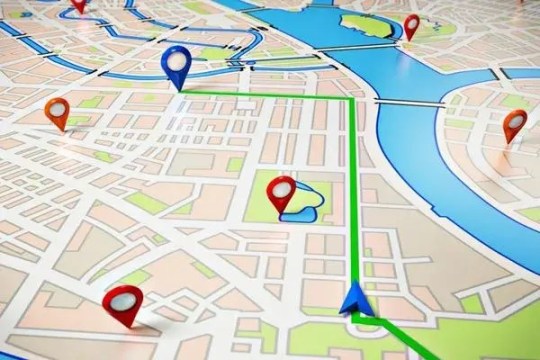
Remote Monitoring and Control: A lot of self-driving cars come with features that let their operators monitor and manage operations from a distance. This function improves safety and enables on-the-fly modifications in real time.
Interoperability: Autonomous vehicles can interact with other farm equipment and management systems in an agricultural setting to enable coordinated activities like planting, harvesting, and irrigation.
Safety Features: Safety is a top priority in the design of autonomous cars. To avoid collisions, they frequently have emergency stop systems and collision avoidance systems.
Advantages of Autonomous Agricultural and Construction Vehicles
The construction and agricultural industries stand to gain greatly from the many benefits that autonomous cars provide. The following are some of the main benefits:
Enhanced Productivity: Because autonomous cars can operate nonstop, they can accomplish tasks more quickly and with more efficiency. This is especially helpful in agriculture, where crop output depends on timely tasks like planting and harvesting.
Precision and Consistency: These vehicles follow predetermined routes and carry out jobs consistently, operating with a high degree of precision. Increased crop productivity, higher-quality building, and more efficient use of resources are all possible outcomes of this precision.
Cost Savings: Since autonomous cars require fewer human operators, labor costs may be lower in the long run. They use less fuel and resources because they run more effectively.
Operational Efficiency: Using information from sensors and AI algorithms, autonomous cars may instantly modify their course and optimize their routes. This flexibility leads to less waste and more effective use of resources.
Safety: Autonomous vehicles in the construction industry can carry out dangerous operations, such as excavation and demolition, without endangering human operators. They can lessen the physical strain on employees and assist in preventing field accidents in agriculture.
24/7 Operation: Since autonomous vehicles don’t need to sleep or take breaks, they can operate around the clock. This is especially useful at the most important times of the agricultural cycle.
Reduced Environmental Impact: By using resources like water and fertilizers more effectively, autonomous agricultural vehicles can lessen their negative effects on the environment and increase sustainability. Waste in construction can be decreased by optimizing resource use.
Data Gathering and Analysis: A multitude of data regarding the environment, agricultural conditions, and building sites can be gathered by these vehicles. To improve operations, long-term planning, and decision-making, this data can be evaluated.

Disadvantages of Autonomous Agricultural and Construction Vehicles
Although autonomous Agricultural and Construction Vehicles have many benefits, there are a number of drawbacks and difficulties that must be taken into account when putting this technology into practice. The following are some of the main drawbacks:
High Initial Costs: The acquisition and assimilation of self-driving cars and related technologies might be costly, potentially impeding their widespread use, particularly in small and medium-sized enterprises.
Maintenance and Repairs: Because autonomous cars are intricate machinery, they occasionally need professional personnel for repairs in addition to routine maintenance. When compared to conventional vehicles or equipment, maintenance expenses may be higher.
Liability and Legal Issues: Determining who is responsible for accidents or mistakes involving self-driving cars might be complicated, necessitating modifications to existing legal frameworks. It might be difficult to navigate the legal and regulatory environment.
Data security: A lot of data, including environmental and mapping data, is gathered and sent by autonomous cars. To stop misuse, hacking, or theft, it is essential to protect the security and privacy of this data.

Job Displacement: In industries where labor has historically been needed, the use of autonomous cars may result in employment displacement. It will be difficult to manage the social and economic effects of this relocation.
Technological Restrictions: Because autonomous cars rely on a variety of sensors and technology, they could have trouble operating in inclement weather, dimly lit areas, or challenging terrain. Restrictions imposed by technology may hinder their performance.
Human Oversight and Intervention: The ability of autonomous cars to function fully independently may be limited if they still need human supervision to manage difficult or unexpected scenarios.
Adaptation and Training: To properly operate, monitor, and maintain autonomous vehicles, personnel and operators may need to complete training. It may require some time and effort to become used to this new technology.
Conclusion:
In conclusion, autonomous agricultural and construction vehicles represent a transformative leap forward in the fields of farming and construction. These vehicles offer a wide array of benefits, including increased productivity, precision, cost savings, and enhanced safety. They have the potential to revolutionize the way we approach tasks in these industries, making them more efficient, sustainable, and safe.
However, their adoption is not without challenges. High initial costs, regulatory complexities, maintenance requirements, and potential job displacement are factors that must be carefully considered. These challenges emphasize the need for a strategic approach to implementation and a focus on long-term planning.
Despite these challenges, the advantages of autonomous vehicles cannot be overlooked. As technology continues to advance and regulations catch up, the integration of autonomous agricultural and construction vehicles is likely to become more widespread. The key will be to balance the advantages with the disadvantages and mitigate potential risks effectively.
In the coming years, as technology evolves and becomes more accessible, autonomous agricultural and construction vehicles have the potential to drive significant improvements in efficiency, safety, and sustainability, ultimately benefiting both businesses and the broader society. It is a promising path towards a future where we achieve more with less, while also ensuring that our agricultural and construction industries remain competitive and environmentally responsible.
#Autonomouscontrols#Agriculturalvehicles#ConstructionVehicles#selfdrivingcars#KeylessEntry#Cybersecurity#StartSystems#dorleco#controlsystem#ADAS#eMobilityControls#AVRescueProtocols#automotive#controlunit
0 notes
Text

Startek Industrial is an industrial contracting company located in Edmonton, Alberta, Canada. They specialize in mechanical, electrical, and instrumentation services for the oil & gas, refining, petrochemical, power generation, and infrastructure industries.
Some of the specific services they offer include:
Mechanical installations, maintenance, and turnaround support for rotating equipment, pressure vessels, heat exchangers, piping systems, and more
Electrical and instrumentation contracting services covering motor control centers, switchgear, variable frequency drives, control systems, and field device installation
Fabrication capabilities for skids, modules, pipe spooling, and custom equipment
Scaffolding and insulation services
Staff augmentation to supplement client project teams
Startek Industrial employs over 60 staff and has been operating for over 25 years. They have a strong safety record and focus on building long-term relationships with clients through consistent, quality work. The company services projects across Western Canada.
#industrialcontracting#mechanicalservices#electricalservices#instrumentation#oilandgas#refining#petrochemical#powergeneration#infrastructure#rotatingequipment#pressurevessels#heatexchangers#pipingsystems#motorsystems#switchgear#drives#controlsystems#fabrication#skids#modules#spooling#customfabrication#scaffolding#insulation#staffaugmentation#safetyleaders#technicalservices#westerncanada#YEGbusiness#madeinedmonton
1 note
·
View note
Text
Industrial Control and Factory Automation Market Size 2024 Research Report by Global Growth Rate, Development Strategy, Recent Trends, and Regional Demand till 2030
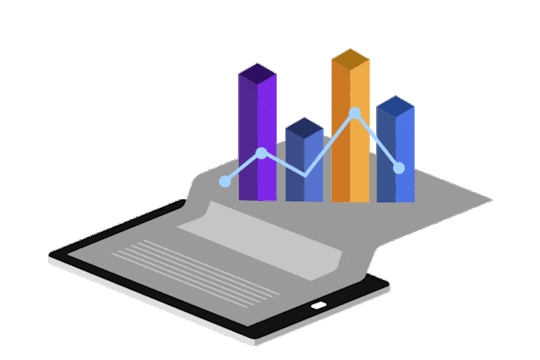
The qualitative report published by Exactitude Consultancy research on the “Industrial Control and Factory Automation Market offers an in-depth examination of the current trends, latest expansions, conditions, market size, various drivers, limitations, and key players along with their profile details. The Industrial Control and Factory Automation market report offers the historical data for 2018 to 2023 and also makes available the forecast data from the year 2024 to 2030 which is based on revenue. With the help of all this information research report helps the Market contributors to expand their market positions. With the benefit of all these explanations, this market research report recommends a business strategy for present market participants to strengthen their role in the market. This report analyzes the impact of the Covid 19 pandemic on the Industrial Control and Factory Automation Market from a Global and Regional perspective.
The Industrial Control and Factory Automation Market Is Expected to Grow At 10.5% CAGR From 2022 To 2029. It Is Expected to Reach Above USD 297.51 Billion By 2029 From USD 129.1 Billion In 2023.
For The Full Report Click here:
https://exactitudeconsultancy.com/reports/24982/industrial-control-and-factory-automation-market/
#FactoryAutomation#ManufacturingAutomation#IndustrialAutomation#AutomationTechnology#ControlSystems#ProcessAutomation#SmartManufacturing#IndustrialIoT#Industry40#SmartFactory#DigitalFactory#AutomatedManufacturing#PLC#SCADA#RoboticsAutomation#IoTinManufacturing#ProductionControl#MachineAutomation#FactoryFloor
0 notes
Text
youtube
Earlier this week I finally managed to get my FX5S Mitsubishi PLC to communicate with my OPC UA Server. I had implemented an SLMP connection on the PLC and attempted to connect so I could update tags to then pull the data in FactoryIO. I could not PING my PLC but I could program it which really baffled me. Turns out ICMP requests were being blocked by my antimalware SW and firewalls. So I made exceptions. I use my ISPs router and so I also had to define a static IP, default gateway, and subnet on the router side then allow my router to define them. I also figured out how to connect via a managed switch so now I can add more connections such as other PLCs, robot controllers, HMIs, my pi zero server, and optiplex server.
The above is just proof of connection with stupid basic code for a simulation. It is not anything well written as there is zero error handling etc.
0 notes
Text
Serge Vessel – Level Control
S.R. Bhat (Technical Director, COMFIT)
Many times, a product produced in a process equipment is used as feed to another equipment. In these cases, it is necessary to make the feed flow to the second equipment steady, i.e. any variations in the feed should be very slow. This must be achieved even if the product out coming put of the first equipment is not steady. E.g. Naphtha coming out of the crude distillation unit of a refinery is unstable, i.e. it contains a lot of volatile components. These volatile constitute Liquefied Petroleum Gas (LPG), which is very valuable. This stream is fed to another distillation column called Naphtha Stabilizer. Purpose of the Naphtha Stabilizer are two. They are:
1. Recover the LPG, allowing minimum slippage of LPG to Naphtha.
2. Remove LPG from Naphtha with minimum slippage of Naphtha to LPG. To achieve this, a serge vessel is introduced in between the Crude Distillation Column and the Naphtha Stabilizer. Feed flow into the stabilizer is controlled by a control valve introduced between the serge tank and stabilizer. Process variable for this control loop is the liquid level in the serge tank. This level keeps varing around 50%. If this controller is well tuned, level will always mainted tightly near the 50 % mark. This would defeat the purpose of surge vessel by making the vessel outlet flow closely follow the badly varing inlet flow. On the other hand, by keeping the controller sluggish (i.e. making proportionality gain low), the surge tank serves its purpose. When the input flow to the serge vessel increses, sluggish level controller acts very slowly, resulting in the slow and steady increase of outlet flow from the vessel. This increses the level in the serge tank. On the other hand, when the inlet flow to the serge vessel reduces, exactly the reverse happens.
This is a strange case of attuned controller gives the desire result. This has been successfully done in the Naphtha Stabilizer of refinery, which resulted in substantial increase in of the production of the valuable LPG, but also improved its weathering.
#SergeVessel hashtag#LevelControl hashtag#ProcessEngineering hashtag#FeedFlowStabilization hashtag#NaphthaStabilizer hashtag#LPGRecovery hashtag#ControlSystem hashtag#ProcessOptimization hashtag#RefineryTechnology hashtag#SurgeTankSuccess hashtag#EfficientProduction hashtag#ProcessControl hashtag#SteadyFeedFlow hashtag#industrialengineering hashtag#comfit hashtag#valvemanufacturer hashtag#valves hashtag#valveindustry hashtag#valvefactory hashtag#india
0 notes



